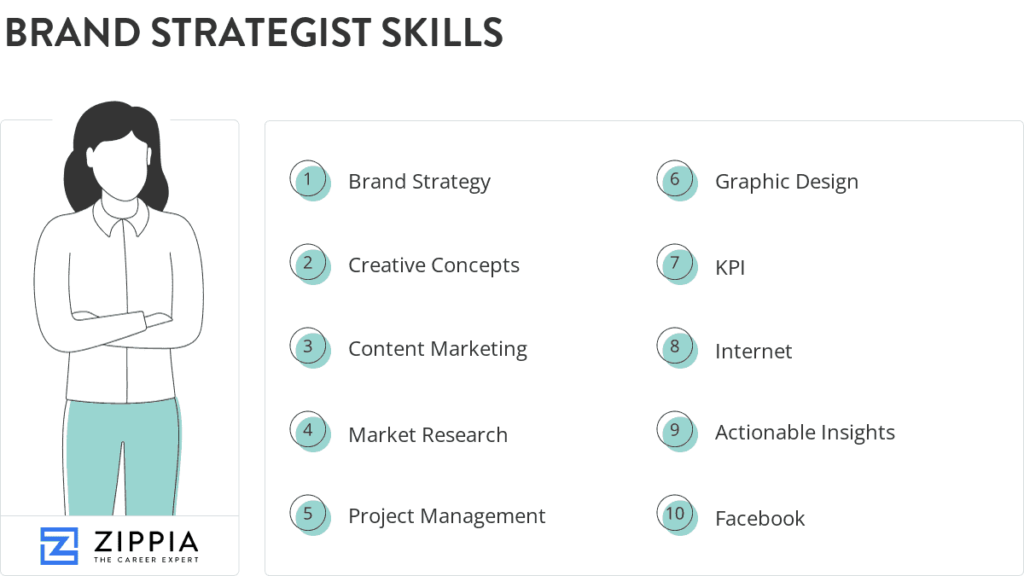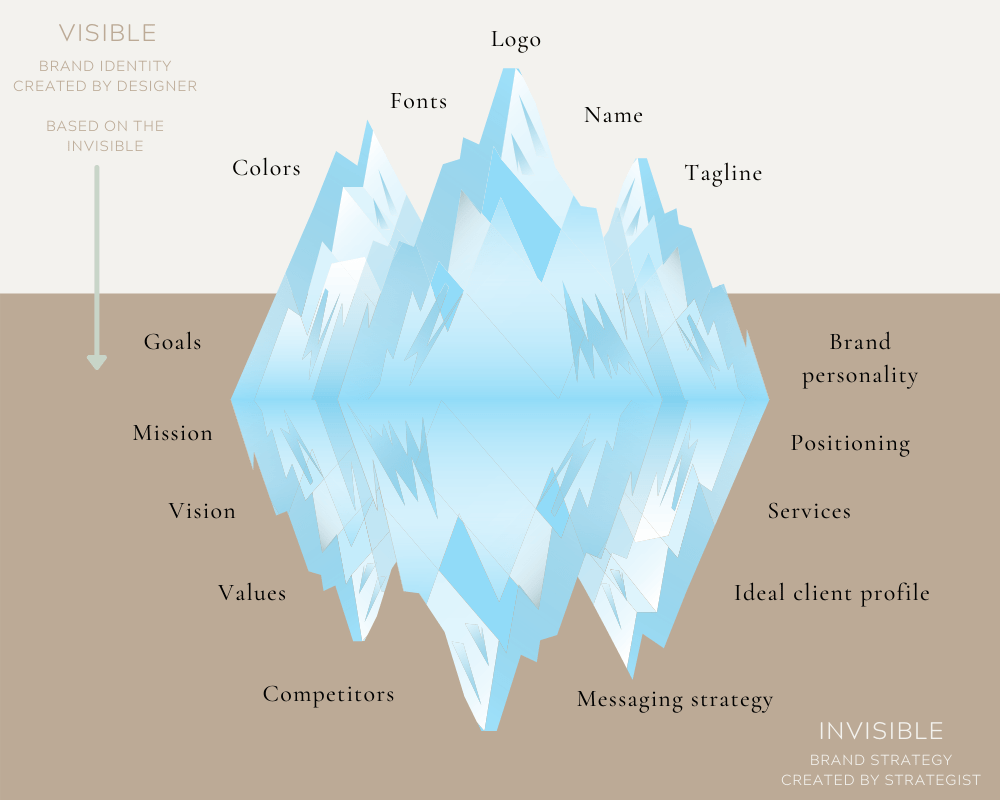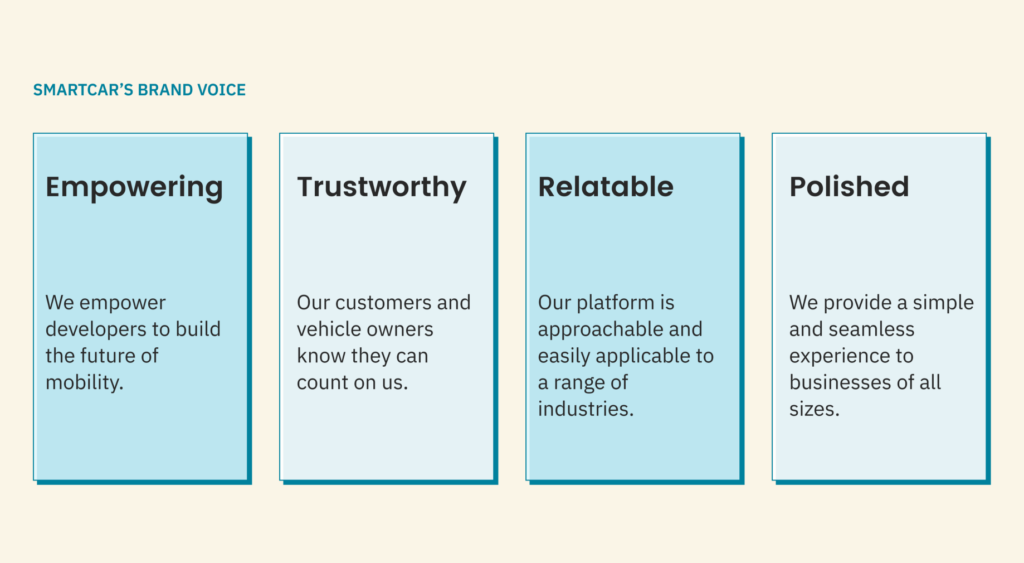How a Brand Strategist Can Elevate Your Business
You've spent countless hours nurturing your dream, putting together the pieces of your business puzzle, and now it's time for your big launch. But then, crickets. The big question hits you—why isn't your brand connecting with your target audience?
Well, let me share a little secret. Building a successful business is much more than having a great product or service. It's about crafting a compelling brand story, connecting emotionally with your audience, and consistently conveying your value proposition. And who better to do this than a brand strategist?
A brand strategist is like the secret sauce to your business recipe. Their magic wand can transform your brand into a powerhouse, making it irresistible to your target audience. And believe me, this is not just fluff; solid numbers back it.
According to a 2021 survey by Lucidpress, consistently presented brands are 3.5 times more likely to enjoy excellent brand visibility. Not only that, but they also see a 33% increase in revenue compared to those with an inconsistent brand presentation. Now, imagine what an experienced brand strategist can do for your business!
In this blog, we're diving deep into the world of brand strategists—unveiling their roles, demonstrating their value, and showcasing how they can take your business from being ‘just another company' to ‘the company' in your industry. Buckle up; it's going to be an enlightening ride!
Table of Contents
Understanding the Role of a Brand Strategist

They're the experts in creating and executing killer brand strategies for businesses. These folks have a knack for understanding consumer behaviour, the ever-changing market landscape, and all the ins and outs of brand management. They're like the architects of a company's brand, working hand in hand with clients to uncover what makes them special, identify their target audience, and define their business objectives.
To do their magic, brand strategists dive deep into market trends, meticulously study competitors, and tap into valuable consumer insights. They're like detectives, gathering all the puzzle pieces needed to craft a comprehensive brand strategy that perfectly aligns with the client's goals. It's all about creating a roadmap for success.
Imagine sitting down with a brand strategist. You're in for a collaborative adventure where they'll ask you thought-provoking questions to uncover the essence of your brand. They'll want to know what makes your business unique, what drives your customers to choose you over the competition, and where you envision your company heading.
Once they've gathered all the necessary information, they'll put on their analysis hat and start dissecting market dynamics. They'll examine the latest trends, industry shifts, and consumer preferences, carefully examining every nook and cranny to uncover hidden opportunities. They'll also watch your competitors, analysing their strategies, strengths, and weaknesses. It's all about finding that sweet spot where your brand can shine.
But it doesn't stop there. With all this knowledge, brand strategists embark on the creative journey of crafting a brand strategy that hits the bullseye. They'll distil all the information gathered into a concise plan outlining your brand's unique value proposition, target audience, and the steps needed to achieve your business objectives. It's like a blueprint for success, guiding every aspect of your brand's communication, positioning, and customer experience.
Brand strategists work closely with clients throughout the process, acting as trusted advisors and creative partners. They're not just experts but collaborators who value your input and vision. Together, you'll shape a brand strategy that captures the essence of your business, resonates with your audience, and propels you towards success.
The Importance of Brand Strategy
When businesses have a clear brand strategy, it sets them apart from their competitors, fosters genuine connections with customers, and paves the way for long-term growth. Exciting stuff, right?
You'll be thrilled to know that a study conducted by Forbes confirms the remarkable benefits of a strong brand strategy. Companies that have nailed their brand strategy enjoy a bunch of perks. First, they experience a higher customer retention rate, meaning their customers stick around for the long haul. That's a huge win because it saves businesses from constantly scrambling to find new customers and allows them to focus on nurturing existing ones.
But wait, there's more! These businesses also bask in the glory of increased brand loyalty. When customers feel strongly connected to a brand, they become loyal fans who keep returning for more. It's like having a tribe of devoted supporters who spread the word about your excellent products or services. Who doesn't love a bunch of enthusiastic brand advocates?
Here's the cherry on top: a solid brand strategy gives businesses a significant competitive advantage. By clearly defining what makes them unique and special, they stand out from competitors vying for attention. It's like having a dazzling spotlight on your brand while others fade into the background. Pretty cool, huh?
But hold your horses; we're not done yet! A well-executed brand strategy also has a magical effect on perceived value. When customers recognise and connect with a brand's distinct qualities, they associate it with higher quality and greater worth. And you know what that means? Businesses can charge premium prices for their products or services because customers are willing to pay more for that exceptional brand experience. Cha-ching!
And here's the grand finale: all these fantastic outcomes lead to greater profitability. A strong brand strategy unlocks many opportunities for businesses to grow and thrive. With a devoted customer base, increased brand loyalty, and a competitive edge, companies can enjoy a steady stream of revenue and boost their bottom line. It's like an ever-flowing fountain of success!
The Skills of a Brand Strategist

To excel in their role, brand strategists possess a diverse set of skills and expertise. These include:
- Market Research: Brand strategists conduct thorough market research to gain insights into industry trends, consumer preferences, and competitive landscape. This helps them identify market gaps and opportunities, enabling businesses to position their brand strategically.
- Brand Positioning: Brand strategists determine a brand's unique selling proposition (USP) and craft a positioning strategy that differentiates it from competitors. They define the brand's personality, values, and messaging to create a compelling and authentic identity.
- Consumer Insights: Understanding the target audience is crucial for effective brand strategy. Brand strategists use various research methods to gather consumer insights, such as surveys, focus groups, and monitoring social media. These insights shape the brand's messaging and enable businesses to connect with their target market on a deeper level.
- Creative Thinking: Brand strategists possess a creative mindset that allows them to think outside the box and develop innovative brand strategies. They use creative techniques to generate ideas, build brand narratives, and design memorable brand experiences.
- Analytical Skills: Brand strategists analyse market data, consumer behaviour, and performance metrics to evaluate the effectiveness of brand initiatives. They use this data-driven approach to refine strategies, optimise brand messaging, and maximise return on investment (ROI).
The Process of Brand Strategy Development
Developing a robust brand strategy requires a systematic approach encompassing research, analysis, planning, and execution. Brand strategists follow a structured process to ensure the brand strategy aligns with the client's objectives and resonates with the target audience.
Discovery Phase

In the discovery phase, brand strategists roll their sleeves and immerse themselves in the client's business. They embark on an exciting journey of understanding everything about the client's brand, target market, and competitive landscape. It's like diving into a treasure hunt for valuable insights!
To begin with, they conduct in-depth market research. They delve into various data sources and conduct thorough analyses to comprehensively grasp the current market trends, consumer preferences, and emerging opportunities. It's all about gathering the puzzle pieces and forming a clear picture of what's happening in the industry.
But that's not all. The brand strategists put their detective hats on and dive deep into competitor analysis. They carefully examine the client's competitors' strategies, strengths, and weaknesses. Doing so, they understand the competitive landscape and identify areas where the client can outshine the competition.
In addition to researching the market and studying the competition, brand strategists seek valuable insights from key stakeholders. They engage in conversations with the client's team members, executives, customers, and other individuals with essential perspectives. These insights serve as precious gems that shed light on the brand's current positioning, strengths, and areas where improvement is needed.
By the end of the discovery phase, the brand strategists have a treasure trove of knowledge. They've gained a comprehensive understanding of the client's business, the needs and desires of their target market, and the competitive forces at play. Armed with this wealth of information, they're ready to unveil opportunities for improvement, refine the brand's positioning, and chart a course for success.
Strategy Development
So, after all the essential information is gathered, brand strategists kick it up a notch and dive into the exciting task of developing a comprehensive brand strategy. It's like assembling all the puzzle pieces to create a cohesive and compelling brand image.
First, they start by defining the brand's core values, the guiding principles that shape its identity. These values are the foundation upon which every other aspect of the strategy is built. It's all about determining what the brand stands for, what it believes in, and how it wants to make a difference in the world.
Next, they identify the brand's unique selling proposition (USP). This is that special something that sets the brand apart from the competition. It's like a secret weapon that makes customers choose your brand over others. Whether outstanding quality, exceptional customer service, or innovative features, the USP gives the brand its edge in the market.
Of course, no brand strategy is complete without considering the target audience. Brand strategists work magic to understand the ideal customers' wants, needs, and desires. By delving deep into their psychographics and demographics, they can create a strategy specifically catering to this audience, speaking their language and addressing their pain points.
Once these foundational elements are in place, it's time to move on to the more tangible aspects of branding. Brand positioning is all about finding that sweet spot in the market where the brand can effectively differentiate itself and connect with its target audience. It's like finding the perfect place on a crowded dance floor to groove to the beat and grab everyone's attention.
Messaging is another crucial component of the brand strategy. It involves crafting the brand's voice and tone and determining how it communicates with its audience. The messaging should be consistent, clear, and compelling, conveying the brand's values and USP in a way that resonates with customers. It's about speaking their language and creating a bond beyond product features.
Visual identity is the cherry on top of the brand strategy cake. It's all about designing a captivating visual representation of the brand, including its logo, colour palette, typography, and overall aesthetics. The visual identity should align with the brand's values and messaging, evoking customers' desired emotions and perceptions. It's what catches the eye and leaves a lasting impression.
Lastly, brand strategists know that storytelling is a powerful tool. They craft a brand narrative that weaves together all the elements of the strategy into a compelling and memorable story. This narrative creates an emotional connection with customers, making them feel part of something bigger than a transaction. It's about building a relationship based on trust, authenticity, and shared values.
So, developing a brand strategy is like painting a masterpiece. It requires careful consideration of the brand's values, USP, target audience, positioning, messaging, visual identity, and storytelling. When all these elements come together harmoniously, they create a brand that stands out from the crowd and resonates deeply with customers, forging a lasting connection beyond the surface.
Implementation and Execution

Once the brand strategy is set and ready, brand strategists dive into the exciting phase of working closely with their clients to implement it. It's like turning a well-crafted blueprint into a breathtaking architectural masterpiece. These strategists are the creative maestros who orchestrate the implementation and execution of the brand strategy across different touchpoints, ensuring that every interaction with the brand leaves a lasting impression.
Imagine them as the conductors of a symphony, carefully directing each instrument (or touchpoint) to play in harmony. Their first task is to design the brand's visual identity, crafting a stunning visual language that captures the essence and personality of the brand. From the logo design to the choice of colours, fonts, and imagery, every element is carefully chosen to create a visual story that resonates with the target audience.
Brand strategists also create comprehensive brand guidelines that serve as the North Star for all brand-related activities. These guidelines outline the dos and don'ts of brand representation, ensuring everyone involved in showcasing the brand knows how to do it justice. It's like a set of brand commandments that maintain consistency and integrity across all brand touchpoints.
With the visual identity and brand guidelines in place, the strategists roll up their sleeves and develop impactful marketing campaigns. They strategise, brainstorm, and collaborate with creative teams to create campaigns that cut through the noise and capture the hearts and minds of the target audience. They know how to craft compelling messages that resonate, using storytelling techniques and emotional triggers to forge a deep connection with customers.
However, brand strategists don't work in isolation. They understand the importance of internal alignment. So, they work closely with internal stakeholders, such as employees, executives, and departments, to ensure everyone is on the same page. They align these stakeholders with the brand vision through effective communication and collaboration, fostering a shared understanding and commitment to delivering a consistent brand experience.
Brand strategists act as guardians of the brand message throughout the customer journey. They ensure that every touchpoint, whether a website, social media post, advertisement, or even a customer service interaction, reflects the brand's personality and values. They strive to create a seamless and cohesive experience where customers feel a sense of familiarity and trust at every step.
Monitoring and Evaluation
Once the brand strategy is up and running, brand strategists don't just sit back and relax – they roll up their sleeves and dive into monitoring and evaluating its performance. It's like being the brand's detective, always keeping a close eye on how things are going.
They have a trusty toolbox of tools and techniques to help them gauge the strategy's impact. One of their go-to weapons is tracking key performance indicators, or KPIs for short. These are like little breadcrumbs showing how the brand is faring in the grand scheme of things. Are sales skyrocketing? Is brand awareness through the roof? By analysing these KPIs, strategists can see the tangible results of their efforts.
But it's not just about the complex numbers. Brand strategists also know that perception is everything. They want to understand how people perceive the brand, its emotions, and its position in the market. So, they roll up their sleeves and get busy measuring brand perception. They conduct surveys, gather feedback, and even tap into social media to see what people say. This treasure trove of information helps them understand whether the brand is hitting the right notes with its target audience.
Customer feedback is like gold to brand strategists. They cherish every bit of it because it gives them insights into what's working and what's not. It's like having a direct line to the thoughts and opinions of the customers who matter most. They eagerly listen to what customers say through surveys, reviews, or even face-to-face interactions. With this feedback, they can evaluate the strategy's effectiveness and identify improvement areas.
The best part is that brand strategists gather more than just this information for the sake of it. They put it to good use. Armed with data-driven insights, they make adjustments and optimisations to keep the brand on track. They tweak messaging, refine marketing campaigns, or even reposition the brand if necessary. It's all about staying relevant, resonating with the target audience, and ensuring the brand's continued success.
The Impact of Brand Strategy on Business Success
A well-executed brand strategy has a profound impact on the success of a business. Let's explore some key benefits companies can expect when investing in strategic brand development.
Increased Brand Awareness

The first step is to create a brand identity that is both distinctive and captivating. You want your brand to be instantly recognisable and leave a lasting impression on your audience. It's like crafting a unique personality for your business that resonates with people. When your brand identity is well-defined, you have a better chance of cutting through the noise and capturing the attention of your desired customers.
But why does brand awareness matter so much? Well, think about it this way: if people don't know about your brand, they won't consider it when purchasing. A study by Nielsen confirmed that solid brands with high levels of awareness are more likely to be viewed by consumers during the buying process. So, building brand awareness is crucial for gaining a competitive edge in the market.
This is where a skilled brand strategist comes in. They can leverage various marketing channels to amplify your brand's visibility and attract new customers. Social media platforms like Facebook, Instagram, and Twitter provide excellent opportunities to engage with your target audience and spread the word about your brand. Creating compelling content and interacting with users can build a loyal following and increase brand recognition.
Content marketing is another powerful tool in the brand strategist's arsenal. You can establish yourself as an authority in your industry by producing high-quality and relevant content, such as blog posts, articles, videos, or podcasts. This boosts your brand's visibility and builds trust and credibility with your audience.
Of course, advertising plays a vital role as well. A brand strategist can ensure that your message reaches the right people at the right time through targeted advertising campaigns. Whether it's display ads, search engine marketing, or influencer partnerships, the goal is to create a buzz around your brand and entice potential customers to explore your offer.
Enhanced Brand Perception
Imagine this: you come across a company that consistently shares its values, promises, and benefits. You see it everywhere, from their social media posts to their website and packaging. They're speaking directly to you, understanding your needs and desires. This level of consistency and clarity in communication catches your attention and builds trust and credibility in your mind.
You're not alone in feeling this way. A recent survey by Edelman revealed that 67% of consumers need to trust a brand before purchasing. That's significant, highlighting that trust is vital in consumer decision-making.
This is where a brand strategist comes into play. By investing in a brand strategist, businesses can unlock the power of creating a positive brand image that truly resonates with their customers. It's like having a mastermind behind the scenes, working diligently to align the brand's values and promises with the desires and aspirations of its target audience.
Think of it as building a bridge between the brand and its consumers. When a brand consistently and authentically communicates its core values, it establishes a sense of reliability and familiarity. It becomes a brand that people can depend on and turn to whenever they have a specific need or desire.
But it's not just about building trust and credibility. When a brand's strategy is on point, it can increase loyalty and advocacy. Customers who align with the brand's values and powerfully connect to it are likelier to become loyal supporters. They continue choosing the brand for their needs and eagerly recommend it to their friends, family, and strangers online.
And let's remember the power of word-of-mouth marketing. When customers become brand advocates, they become the brand's best marketers. They share their positive experiences and genuine love for the brand with others, amplifying the brand's reach and attracting new customers. It's like a domino effect, starting from a well-crafted brand strategy.
Competitive Advantage
By boldly highlighting your unique value proposition and what sets you apart, you position yourself as the go-to choice for consumers. It's like standing out in a crowd of wannabes!
And here's the best part: when you have such a strong brand strategy, you're not only attracting customers, but you're also able to command premium prices for your products or services. People are willing to pay more for something they believe in, which resonates with them deeper. So, not only are you raking in the profits, but you're also building a loyal customer base.
Now, let me hit you with some stats. A study conducted by McKinsey, those numbers people, found that companies with powerful brands outperform their competitors by a whopping 73% in terms of total return to shareholders. That's incredible! It shows that a well-crafted brand strategy isn't just fluffing; it's a solid investment that pays off big time.
A solid brand people recognise, and trust gives you an edge in the market. Customers naturally gravitate towards businesses they know and love so that you can secure a more extensive market pie. It's like having your fan club cheering you on while your competitors scramble to catch up.
Customer Loyalty and Advocacy

It's not just about making sales and attracting customers—building long-term relationships and fostering customer loyalty and advocacy. Something magical happens when customers feel a genuine emotional connection with a brand. They become more than repeat buyers; they become devoted advocates.
You won't believe the impact of emotional connections on a brand's bottom line! According to a fascinating report by Deloitte, customers who form an emotional bond with a brand have a whopping 306% higher lifetime value than those who don't. That's an incredible statistic showcasing the importance of creating meaningful customer connections.
To achieve this, brand strategists put their hearts and souls into crafting a brand experience that truly resonates with customers. It's about more than just a product or a service; it's about creating an entire experience that customers can relate to personally. A solid emotional connection is formed when a brand understands and addresses its customers' needs, desires, and aspirations.
This emotional connection is the key to fostering loyalty. When customers feel understood and valued, they're more likely to stick around for the long haul. They become loyal patrons who repeatedly choose your brand over others, even when similar options are available. It's like having a devoted friend who will always be by your side, supporting your brand through thick and thin.
But the benefits don't stop there. When customers are emotionally connected to a brand, they can't help but share their positive experiences with others. They become brand ambassadors, spreading the word about your unique products or services. This positive word-of-mouth marketing is compelling, as people trust recommendations from friends and family more than any advertisement. By generating positive word-of-mouth, you tap into a network of potential customers predisposed to trust your brand.
Revenue Growth and Expansion Opportunities
It is fascinating how a strong brand strategy can make or break a business regarding its financial performance. I came across this study by Interbrand that revealed some impressive findings. Companies with a solid brand strategy enjoy higher revenue growth rates than their competitors. Isn't that amazing?
But it doesn't stop there. A well-executed brand strategy goes beyond just boosting revenue. It opens up a whole world of new market opportunities for businesses. Imagine expanding into new product lines or even venturing into different geographic regions, all thanks to a strong brand. It's like having a passport to explore uncharted territories and tap into untapped customer bases.
Oh, and here's something that caught my attention. A solid brand strategy has the power to attract potential investors. Think about it: when investors see a business with a well-defined brand, they see a company that knows who it is, where it's going, and how to connect with its target audience. This level of clarity and professionalism is desirable to investors, and it can open doors to funding and partnerships that might otherwise be difficult to secure.
But wait, there's more! One of the most incredible things about having a solid brand strategy is that it allows businesses to charge a premium for their products or services. It's like having a special secret ingredient that sets your offerings apart. Customers are often willing to pay more for a product or service if they perceive it as having higher value, and a well-crafted brand strategy can create that perception.
And you know what happens when businesses can charge a premium? Profit margins get a boost! So not only does a solid brand strategy help companies to grow their revenue, expand into new markets, and attract investors, but it also enhances their overall profitability. It's like a win-win-win situation.
Collaborating with a Brand Strategist

Now that we understand the importance of brand strategy, you may wonder how to collaborate effectively with a brand strategist. Here are some key considerations to keep in mind:
Clearly Define Your Objectives
So, when working with a brand strategist, you must grasp your business objectives, target audience, and the outcomes you're aiming for. Why? Understanding these key aspects will lay a strong foundation for the brand strategist to create a custom strategy that perfectly aligns with your goals.
Think of it as building a house. You would need a blueprint to start constructing. Similarly, by clearly defining your business objectives, you're sketching the blueprint for your brand's success. It's like setting the destination on your GPS before embarking on a journey.
Next up, your target audience. Knowing who your ideal customers are is like having a treasure map. It helps the brand strategist identify your target audience's specific needs, desires, and pain points, allowing them to craft a strategy that resonates deeply with them. It's all about speaking their language, addressing their concerns, and ultimately winning their hearts.
Lastly, your desired outcomes. What do you want to achieve through your branding efforts? Increased sales? Greater brand awareness? Enhanced customer loyalty? By clearly articulating your desired results, you're setting the goals for your brand strategist. With these in mind, they can devise a comprehensive roadmap to help you reach those goals and exceed your expectations.
By providing all this valuable information upfront, you empower the brand strategist to hit the ground running and develop a tailored approach considering your unique circumstances. They can dig deep into market research, competitive analysis, and consumer insights to craft a strategy that maximises your brand's potential.
Communicate Your Brand's Story and Values

Moving on to your brand's values, you emphasise what your brand stands for. You may prioritise sustainability, craftsmanship, or innovation. Whatever values guide your brand's decisions and actions, articulating them ensures that the strategist comprehends the principles that underpin your brand's identity. These values act as the compass that steers your brand's trajectory, and the strategist aims to align the brand strategy accordingly.
Let's delve into your brand's unique selling proposition (USP). This is the secret sauce that sets your brand apart from the competition. It's that special ingredient that makes customers choose your brand over others. Whether it's a distinctive feature, exceptional quality, or an unmatched customer experience, the USP makes your brand unforgettable. By elucidating your brand's USP, you equip the strategist with a powerful tool to highlight and amplify your brand's competitive advantage.
As the conversation continues, the brand strategist takes notes, asking insightful questions to uncover additional layers of information. They seek to grasp the essence of your brand, its personality, and the emotional connection it forges with its target audience. They aim to immerse themselves in your brand's world, almost as if they were devoted fans. This understanding is pivotal in developing a strategy that resonates deeply with your intended audience, sparking genuine connections and fostering brand loyalty.
Once the brand strategist has absorbed all the intricate details you've shared, they embark on the journey of crafting a strategy that truly captures the essence of your brand. Drawing from the rich tapestry of your brand's story, values, and USP, they devise a roadmap that aligns your brand's identity with the desires and aspirations of your target audience.
Remember, effective communication is the key. By openly sharing your brand's story, values, and USP, you lay the groundwork for a fruitful collaboration with your brand strategist. Together, you'll create a strategy that showcases your brand in its best light and resonates powerfully with those you aim to captivate.
Provide Access to Relevant Data and Insights
Regarding brand strategy, accessing relevant data and insights about your target market, customer preferences, and industry trends can be a game-changer. By sharing this valuable information, you're equipping the brand strategist with the power to make informed, data-driven decisions and craft a strategy firmly grounded in the realities of the market.
Think about it this way: if you want to sail on a successful branding voyage, you need a sturdy ship, right? Well, that ship is built on a foundation of knowledge and understanding. By sharing pertinent data about your target market, you're handing over the compass to guide the brand strategist in the right direction.
Understanding your customers' preferences is like unlocking a treasure chest of insights. It's like having a secret map that reveals your target audience's hidden desires, needs, and behaviours. Armed with this information, the brand strategist can navigate the vast ocean of possibilities and tailor the brand strategy to resonate with the hearts and minds of your customers.
But it doesn't stop there! Industry trends are the wind in the sails, propelling your brand strategy forward. By staying in tune with the latest developments and shifts within your industry, the brand strategist can harness the power of these trends to create a strategy that adapts to the changing landscape, seizes opportunities, and stays ahead of the competition.
In a way, sharing data and insights with your brand strategist is like giving them a pair of binoculars, allowing them to scan the horizon for potential challenges and opportunities. It's about empowering them to make smart, calculated decisions rather than relying on guesswork or gut feelings alone.
Foster Open Communication and Collaboration

Working hand in hand with a brand strategist is crucial when crafting a successful brand strategy. It's like embarking on a collaborative journey where open communication, constructive feedback, and active participation are vital ingredients for achieving a final brand strategy that genuinely captures your vision and aligns with your goals.
Think of your collaboration with a brand strategist as a partnership where both parties bring expertise and insights. By fostering an environment of open communication, you lay the foundation for a productive working relationship. Encourage the strategist to share their thoughts, ideas, and expertise while expressing your perspective and brand aspirations.
In this collaborative process, feedback plays a vital role. Be bold about providing your thoughts and opinions on the proposed strategies and concepts. Your feedback serves as valuable guidance to the strategist, helping them refine their approach and ensure the brand strategy is tailored to your needs. Remember, constructive feedback is not about finding faults but a way to fine-tune and shape the system to reflect your vision better.
Active participation is another crucial aspect. Engage wholeheartedly in the strategy development process, offering insights and contributing your unique perspective. By actively participating, you become an integral part of the creative process, infusing your brand's identity and goals into the strategy. Your involvement ensures that the outcome is a product of the strategist's expertise and reflects your brand's essence.
Embrace the Long-Term Perspective
It's a journey that requires dedication, constant effort, and a willingness to invest your time and resources. Trust me; it's worth it! So, let's dive into the nitty-gritty of brand building and how you can make it happen.
First things first, partnering up with a skilled brand strategist is critical. They'll be your guiding light throughout this process. Together, you'll work on developing a roadmap for implementing your brand strategy and managing it in the long run. It's like having a GPS for your brand's success!
Remember, though, that your brand strategy isn't set in stone. As your business grows and the market shifts, you must continuously evaluate and refine your brand strategy. Think of it as fine-tuning an instrument to create the perfect melody for your customers. Adaptability is the name of the game here.
By regularly assessing your brand strategy, you can ensure that it aligns with your evolving business goals and keeps up with the ever-changing dynamics of the market. After all, you don't want to be playing last year's tune when everyone else is dancing to the beat of something new.
Investing in your brand's consistency is also crucial. It's not enough to make a splash once and then fade into the background. You need to maintain a consistent brand experience across all touchpoints. Your brand identity should shine through consistently, whether it's your website, social media presence, customer service, or even your packaging.
Consistency builds trust and familiarity, creating a lasting impression in the minds of your customers. So, when they think about a particular product or service, your brand should be the first thing that comes to mind. It's all about becoming synonymous with quality, reliability, and an unforgettable experience.
Now, I won't sugarcoat it—it takes time. Building a solid brand is a long-term commitment. It's like nurturing a beautiful garden. You sow the seeds, water them, care for them, and patiently watch them grow. And as your brand blossoms, so will your business.
Conclusion
Brand strategists play a pivotal role in helping businesses unleash the full potential of their brands. By leveraging their expertise in market research, brand positioning, and consumer insights, these professionals develop comprehensive brand strategies that drive growth, build customer loyalty, and establish a unique brand identity.
Investing in a brand strategist can give businesses a competitive edge, increase brand awareness, and pave the way for long-term success. Embrace the power of brand strategy, and unlock the limitless possibilities for your brand's future.
